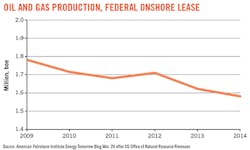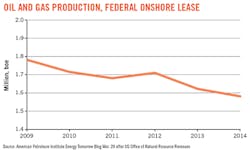Trade groups question DOI's final updated rule for hydraulic fracturing on public, tribal lands
Nick Snow
Washington Editor
Paula Dittrick
Editor
Attorneys representing the Independent Petroleum Association of America and Western Energy Alliance (WEA) have filed a lawsuit in US District Court in Wyoming seeking to set aside new hydraulic fracturing regulations from the Department of the Interior.
In announcing the long-awaited rules for public and tribal lands, government officials said the regulations will improve safety and help protect groundwater by updating requirements for wellbore integrity, wastewater disposal, and public disclosure of chemicals.
"We really are upholding the public trust," Sec. of the Interior Sally Jewell said Mar. 20. "It's been pretty clear that there's a lot of public fear and concern, particularly about groundwater. I don't think anyone would say it makes sense to keep regulations in place from 30 years ago."
The latest regulations were scheduled to become effective June 24 unless blocked by court or congressional action.
Thomas Lorenzen, formerly with the US Justice Department and now a partner with Dorsey & Whitney law firm, said the new rule will create a patchwork of regulatory regimes. Lorenzen worked for more than 10 years as assistant chief in the DOJ's environment and natural resources division.
"Interior's new rule governing hydraulic fracturing may have two near-immediate effects," Lorenzen said. "First, because it applies only on federal and tribal lands, it will create a patchwork of regulatory regimes, making it more difficult for industry to devise uniform practices to limit any possible adverse effects on drilling water from fracturing operations.
"Second, it could well result in an increase in the price of natural gas, thus potentially putting a crimp in the administration's effort to drive energy production away from higher carbon dioxide coal and toward cheap and lower-emitted natural gas-fired power."
Barclays: Limited output effect
The rule will have limited effect on existing US oil and natural gas production, said Barclays Research analyst Michael Cohen in New York.
Onshore oil production from federal and tribal lands accounted for less than 10% of US oil production according to statistics from 2013, the latest available data, Cohen said. Most oil and gas production from federal jurisdiction involves the offshore Gulf of Mexico, he said.
"The rulemaking is significant because states may choose to adopt the standards, though it is unlikely that the federal government will apply it broadly to private lands," Cohen said.
States that provide the main incremental production growth, mainly North Dakota and Texas, will be unlikely to impose more onerous standards than those already in place, Cohen said.
"A great majority of new drilling on federal lands would be affected by the rule," Cohen said. The US Bureau of Land Management "estimates that about 90% of the approximately 2,800 new wells spudded in 2013 on federal and Indian lands were stimulated using hydraulic fracturing."
He said the new rule will apply to growing activity on the Williston basin's Fort Berthold area in North Dakota.
Alan Krupnick, senior fellow with Resources for the Future in Washington, DC, also saw only a limited effect for operators.
"Our rapid assessment is that, other than for the requirement of frac tanks ... no new ground is being broken vis-à-vis the states as a whole," Krupnick wrote in an RFF blog. "All that can be said in general is that with state regulations extremely heterogeneous and the ground shifting so quickly, BLM's regulations are more stringent for some states and less stringent for others."
Krupnick said the final rules represented what he calls a more thoughtful, contemporary approach to regulation than what was already in place. Krupnick is co-director of RFF's Center for Energy and Climate Economics.
BLM comments
BLM Director Neil Kornze, whose agency has charge of implementing and enforcing the rule, said, "I think that once people have an opportunity to look at and analyze this final rule, they'll be very comfortable with its provisions. They'll also like the system to integrate with states which already have put forward their own regulations."
DLA Piper attorneys noted that consensus has begun to build among academia, industry, and state regulators that it is not fracturing but rather faulty well construction that has been responsible for a limited number of associated water-supply contamination events.
"Ultimately, the new federal regulations can be interpreted as a net positive for hydraulic fracturing because the Obama administration has implicitly, if not explicitly, concluded that with proper controls in place, hydraulic fracturing can be done in a manner that is protective of environmental health and safety," said DLA Piper attorneys Robert J. Alessi of New York and Jeffrey D. Kuhn of Albany in an Energy Alert paper that they posted online.
"The Obama administration's position also calls into further question the scientific and factual basis of New York state's recent prohibition on hydraulic fracturing, which was ostensibly based on public health concerns," Alessi and Kuhn said.
DOI officials said that the key components of the rule are:
• Provisions for ensuring the protection of groundwater supplies by requiring a validation of well integrity and strong cement barriers between the wellbore and water zones through which the wellbore passes.
• Increased transparency by requiring companies to publicly disclose chemicals used in hydraulic fracturing to BLM through the web site FracFocus.org, within 30 days of completing fracturing operations. Exceptions for proprietary information would be allowed as long as BLM had access to the information in an emergency.
• Higher standards for interim storage of recovered waste fluids from fracing-specifically, use of rigid, above-ground containers instead of open, lined pits-to mitigate risks to air, water, and wildlife.
• Requirements for companies to submit more detailed information on the geology, depth, and location of preexisting wells to give BLM an opportunity to better evaluate and manage unique site characteristics.
"This rule will protect public health and the environment during and after [fracing] operations at a modest cost while both respecting the work previously done by the industry, the states, and the tribes, and promoting the adoption of more protective standards across the country," said Janice Schneider, DOI's assistant secretary for Land and Minerals Management.
"It will be implemented in the most efficient way possible to avoid duplication or unnecessary activities by industry, other regulators, or BLM staff," Schneider said, adding, "We know how important it is to get this right."
Jewell said, "I think the industry also recognizes that sensible regulation can help them because it helps address public concerns." When a reporter mentioned that some members of Congress had expressed disapproval of the rule, Jewell added, "Political reaction is not surprising, but we're confident from the process we went through that we did the right thing for the American people."
But the rule also quickly drew criticism from an American Petroleum Institute official. "A duplicative layer of new federal regulation is unnecessary, and we urge BLM to work carefully with the states to minimize costs and delays created by the new rule to ensure that public lands can still be a source of job creation and economic growth," said Erik Milito, API upstream and operations director.
He expressed approval for BLM's following the lead of states that have already adopted FracFocus as their preferred tool for making more information public about chemicals used in fracturing fluids.
Associations sue
Attorneys representing the Independent Petroleum Association of America and Western Energy Alliance immediately sued in US District Court for Wyoming, seeking to have the new regulations set aside. "Independent producers operate in a responsible manner that protects the nation's public lands, but the rule BLM has promulgated provides no public benefit," said Mark S. Barron, an associate in Baker & Hostetler LLP's Denver office who worked on the case.
"Requiring oil and gas operators to file repetitive paperwork with multiple government agencies will not prevent or remediate environmental harm," Barron said. "To the contrary, if implemented the rule will rob oil and gas operators of the operational flexibility needed to ensure that the environmental footprint of development is reduced to the greatest extent possible."
IPAA Pres. Barry Russell challenged DOI officials' characterization of the rule as commonsense. "At a time when the oil and gas industry faces incredible cost uncertainties, these so-called baseline standards will threaten America's economic upturn and further deter oil and gas development on federal lands," he said.
Meanwhile, WEA Pres. Tim Wigley observed, "States have been successfully regulating fracing for decades, including on federal lands, with no incident that necessitates redundant federal regulation. BLM struggles to meet its current workload of leasing, environmental analysis, permitting, monitoring, inspecting, and otherwise administering the federal onshore oil and gas program. Yet it is undertaking an entirely new regulatory regime that it has neither the resources nor the expertise to implement."
Kornze said, "On average, these commonsense measures represent less than 0.25% of the cost of drilling a well. These are smart investments that allow the industry to move forward, and assure the public that hydraulic fracturing occurs safely on public and tribal lands."
Working with states
Officials emphasized that the final rule applies only to federally administered lands, but added that state regulations and oil and gas industry standards and practices also will matter.
"There are a number of states where there's oil and gas activity that have no fracing regulations," Jewell said. "These standards may be all they have. There also are several states which already have sophisticated requirements. In those cases, the most stringent standards would apply."
Kornze said, "We work very closely with oil and gas regulators in every state. We plan to sit down them and discuss which rules will apply, and work with them on other efficiencies, particularly concerning inspections where there's a complicated land pattern."
Redundant rules
He said that requiring rigid, above ground containers for handling fluid blowbacks gives BLM more confidence that fracturing crews can manage problems. "It also echoes what already exists in many states," Kornze noted.
Schneider said, "Use of these tanks as a temporary measure for 90 days to manage blowback fluids already is very, very common. Information we've received is that it costs about $5,500/operation."
Asked why DOI is using FracFocus, the voluntary system established several years ago by the Interstate Oil & Gas Compact Commission and the Groundwater Protection Council, Kornze said it would have cost BLM an estimated $25 million to build and operate its own frac fluid ingredient disclosure system. "We have confidence that FracFocus is heading in the right direction, but getting even better," he said.
Jewell added, "When this rule goes into effect, BLM will be the largest customer of FracFocus. It will be represented on the board. FracFocus also has pledged to make improvements which will result in a new version."
Cynthia A.M. Stroman, an attorney with King & Spalding in Washington, DC, said she expects, "The scope and rigor of the confidential business information claims will almost certainly be debated as the rule undergoes judicial review."


